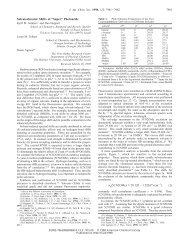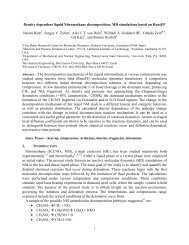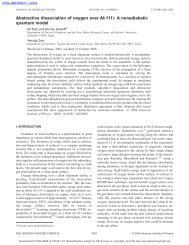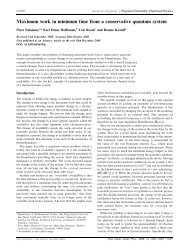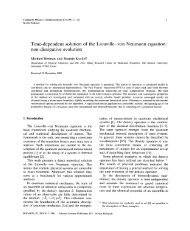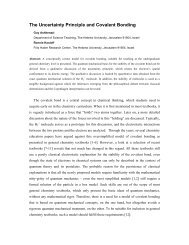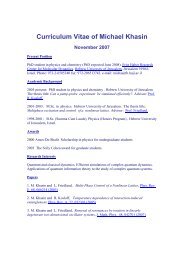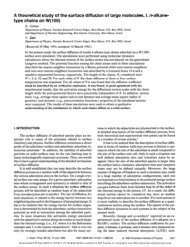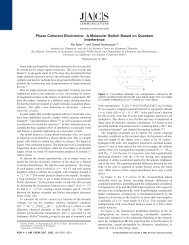Molecular Symmetry Properties of Conical Intersections and ...
Molecular Symmetry Properties of Conical Intersections and ...
Molecular Symmetry Properties of Conical Intersections and ...
Create successful ePaper yourself
Turn your PDF publications into a flip-book with our unique Google optimized e-Paper software.
3004 J. Phys. Chem. A, Vol. 114, No. 9, 2010 Al-Jabour et al.<br />
Figure 6. Torsional nonadiabatic coupling terms (NACTs) <strong>of</strong> C5H4NH, τ 0,1 (r,) (black continuous lines), τ 1,2 (r,) (dashed lines), <strong>and</strong> τ 0,2 (r,)<br />
(gray continuous lines) in the domains 0 e e π/2 (panels a-c) <strong>and</strong> -π e e +π (panels d-f) for r ) 1.0 Å (panels a <strong>and</strong> d), r ) 0.8 Å (panels<br />
b <strong>and</strong> e), <strong>and</strong> r ) 1.2 Å (panels c <strong>and</strong> f), in units <strong>of</strong> 1/radians. Note the different scales, i.e., on one h<strong>and</strong>, the “blown-up” panels a-c discover<br />
details such as the crossing <strong>of</strong> τ 0,1 <strong>and</strong> τ 0,2 which cannot be resolved in panels d-f. On the other h<strong>and</strong>, the “global” panels d-f demonstrate the<br />
patterns <strong>of</strong> the signs <strong>of</strong> the peaks <strong>of</strong> the NACTs, in accord with their irreducible representations in the frame <strong>of</strong> the “global” molecular symmetry<br />
group C2V(M), i.e., B1 for τ 0,1 <strong>and</strong> τ 0,2 as well as B2 for τ 1,2 , c.f. Table 1.<br />
For the other examples, r ) 0.8 <strong>and</strong> 1.2 Å, the signs <strong>of</strong> the<br />
peaks (or the relative maxima) <strong>of</strong> the NACTs τ 0,1 <strong>and</strong> τ 1,2 are<br />
also set to be positive, as for r ) 1.0 Å; compare parts b <strong>and</strong><br />
c <strong>of</strong> Figure 6 with part a, respectively. The consistency <strong>of</strong> this<br />
assignment will be discussed in item xii. Thus, for r ) 0.8 Å,<br />
Figure 6b shows a large positive peak <strong>of</strong> τ 1,2 close to CI1 1,2 which<br />
has been deduced from the near degeneracy <strong>of</strong> V1 <strong>and</strong> V2 close<br />
to ) 1.047 (60°), cf. Figure 5b. In contrast, the increase <strong>of</strong><br />
the energy gap between V1 <strong>and</strong> V0 which has been interpreted<br />
as avoided crossing, suggesting that this is further away from<br />
CI1 0,1 (r ) 0.8, ), causes strong depletion <strong>of</strong> the corresponding<br />
peak value <strong>of</strong> τ 0,1 ; compare parts b <strong>and</strong> a <strong>of</strong> Figure 6. We<br />
extrapolate a general trend from near degeneracies to avoided<br />
crossings with increasing energy gaps between 1-d cuts <strong>of</strong><br />
the PES; these signatures <strong>of</strong> the CIs are located at increasing<br />
distances from the corresponding CIs, causing systematic<br />
decreases <strong>of</strong> the peak values <strong>of</strong> the correponding NACTs, in<br />
accord with the pole property, eq 24. This conjecture is<br />
confirmed by the results shown in Figures 5c <strong>and</strong> 6c for r )<br />
1.2 Å: the previous near degeneracies (Figure 5a for r ) 1.0<br />
Å) are transformed into avoided crossings, not only for V0<br />
<strong>and</strong> V1 (as in Figure 5b) but even more drastically for V1<br />
<strong>and</strong> V2. Figure 6c shows that, indeed, the peak value <strong>of</strong> τ 0,1<br />
at {r ) 1.2 Å, ) π/2} is much smaller than at {r ) 1.0 Å,<br />
) π/2}, Figure 6a. Moreover, the peak for τ 1,2 which was so<br />
obvious in Figure 5a <strong>and</strong> b has decayed to a marginal maximum<br />
value which is hardly noticeable in Figure 6c.<br />
Before moving on to the next items (v, etc.), we note that<br />
close to the boundaries <strong>of</strong> Figure 6a-c, i.e., at ) 0 <strong>and</strong> π/2,<br />
some <strong>of</strong> the τ i,j have decayed to very small values, below the<br />
accuracy <strong>of</strong> the quantum chemistry based method for calculating<br />
the NACTs. In these cases, quantum chemistry per se is not<br />
sufficient to determine the signs <strong>of</strong> the NACTs in these<br />
neighborhoods <strong>and</strong>, therefore, also not in other connected<br />
domains. The solution <strong>of</strong> this dilemma is postponed until item<br />
xi, i.e., after conquering the molecular symmetry properties <strong>of</strong><br />
the NACTs <strong>and</strong> CIs.<br />
(v-vii) It is now straightforward to solve the combined task<br />
<strong>of</strong> the assignment <strong>of</strong> the IREPs <strong>of</strong> the NACTs <strong>of</strong> C5H4NH,<br />
together with their nodal patterns, based on the general theorems<br />
<strong>and</strong> properties which have been derived <strong>and</strong> summarized in<br />
section II, in the frame <strong>of</strong> the molecular symmetry group C2V(M).<br />
Let us first recall that two <strong>of</strong> these properties, i.e., the<br />
quantization rule <strong>and</strong> the pole property, eqs 22 <strong>and</strong> 24, apply<br />
for the model <strong>of</strong> two-state systems. 1 The exclusive peaks <strong>of</strong><br />
the NACTs τ 0,1 ({r ) 1.0 Å, }) <strong>and</strong> τ 1,2 ({r ) 1.0 Å, }) in<br />
narrow domains close to the CI1 0,1 <strong>and</strong> CI1 1,2 demonstrate the<br />
approximate validity <strong>of</strong> the two-state scenario; i.e., there are<br />
apparently no other CIs which interfere with CI1 0,1 or CI1 1,2 close<br />
to [{r 0,1 , 0,1 }]1 <strong>and</strong> [{r 1,2 , 1,2 }]1, respectively, cf. Figure 6a.<br />
This example for r ) 1.0 Å is sufficient for the derivation <strong>of</strong><br />
the IREPs <strong>of</strong> the NACTs, because these are global properties<br />
<strong>of</strong> the MS group C2V(M) <strong>of</strong> C5H4NH; i.e., once they are<br />
determined for the special case r ) 1.0 Å, they apply<br />
automatically also to other values the MS-adapted coordinates.<br />
Let us start from the discovery <strong>of</strong> the CI1 0,1 based on the LH<br />
theorem ()S0/S1 CI (1A′/1A′′), item ii) at 0,1 ) π/2. This<br />
location implies immediately that Γ(τ 0,1 ) ) B1, cf. section II<br />
(vii). We recall that the derivation <strong>of</strong> this result exploits the<br />
quantization rule (22) <strong>and</strong> the pole property (24), in the frame<br />
<strong>of</strong> the two-state model which is approximately valid as discussed<br />
above. Moreover, the general theorem (15) immediately relates<br />
the IREP B1 <strong>of</strong> τ 0,1 to the IREPs <strong>of</strong> all <strong>of</strong> the other NACTs τk 0,1 ,<br />
for the same states i, i + 1 ) 0, 1. Specifically, the radial NACT<br />
has Γ(τr 0,1 ) ) B2, whereas the Cartesian ones (eq 5) have Γ(τx 0,1 )<br />
) A1 <strong>and</strong> Γ(τy 0,1 ) ) A2. Table 1 also lists the corresponding sign<br />
patterns for the peaks <strong>of</strong> the NACTs, as well as their nodal<br />
patterns. As an example, τ 0,1 ({r,}) should have opposite signs<br />
<strong>of</strong> the peaks for ) π/2 <strong>and</strong> -π/2, <strong>and</strong> corresponding nodes<br />
at ) 0 <strong>and</strong> (π.



